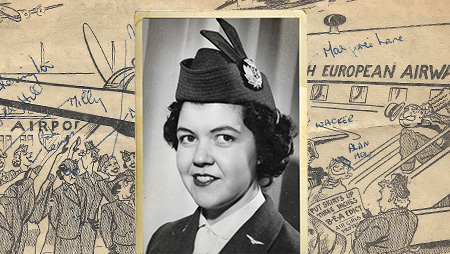August 2024
The secret language of pilots
In this brand-new series, Senior First Officer Al Smith takes us behind the scenes of his high-flying career one topic at a time. First up, we find out what on earth he’s talking about, in this debrief of language in the cockpit
Hi, I’m Al Smith, and I’ll be your pilot today on this BA101 flight to enlightenment. But first, let’s get acquainted.
This journey of mine started 18 years ago. I was fresh out of school in Settle, a quiet town in the Yorkshire Dales, and mad about all things aviation. So mad, in fact, that my parents had to tell me to put the safety card back (and not take it with me) when we went for our annual jaunt down to Lanzarote.

I had already started my PPL (private pilot licence), but my parents – a funeral director and a joiner – couldn’t afford to send me to Oxford to gain my CPL (commercial pilot licence). Desperate to fly big planes to anywhere that would have me, I applied to British Airways as cabin crew and, a few months later, found myself sat at the back of a Boeing 747 on my way to New York City. Not long before, my mother had wanted to know where I was going and what time I would be home… This was freedom at its finest and an (almost) dream come true.
“Allow me to be your personal Duolingo owl as you embark on a beginner’s course in pilot-ese”
At this point, my journey to the flight deck was somewhat put on hold. I didn’t have the money, for one, and I’d just so happened to land this amazing job where you got paid to travel the world. There was no way I was going back to put my head in a book. As cabin crew, I would sometimes sit and watch the pilots pressing all their buttons. I’d think to myself, this is too complicated for me, anyway. Long story short (you’ll have to read my next column to find out the whole story), I got some confidence (and a loan), and was accepted by a flying school in Oxford, where I did initial training for an intensive 20-month stint and spent numerous nights with my head in the aforementioned books. Some years later, I got to the fly the big planes.
Would I do it all again? Yes! But what if I’d been – truly – put off by all those complicated buttons and that jargon? Now that it’s a second language to me, allow me to be your personal Duolingo owl as you embark on a beginner’s course in pilot-ese.

Al suits up at British Airways’ Head Office
Talking in code, like a spy!
Have you ever been on a 78X and sat in J? They say it’s very nice!
(78X = 787-10) (J = Club World).
Yes, you’re in the wonderful world of aviation now – and it’s absolutely chock-full of code. Whether you’re in the head office, cabin crew or a pilot, we all have our own code that can often make us sound as if we’re in some kind of secret discussion. I always think it’s our 007 moment – for one conversation, at least, we could be (really quite terrible) international spies.
Now, do we blame IATA (International Air Transport Association) or ICAO (International Civil Aviation Organisation) for the introduction of all these codes? Or could it be a hangover from the military, where they used an array of codes to a) confuse the enemy – what a jolly good idea, b) get their points across easier and quicker and c) well, it just sounds a bit cooler, doesn’t it? Whatever it was, the use of codes really took off (pardon the pun), and we use them on a daily basis on the flight deck to speak to each other, especially on the radio where it’s really important to convey a message clearly and succinctly.

“Is there any logic?” I hear you ask. Yes, on many occasions, logic has been applied, and some of it can be worked out pretty easily if you know the context in which the code is being used. For instance, if I tell you the PIC is responsible for the safety of everyone on board, you may well work out that it is, of course, the pilot in command. Acronyms are also, as mentioned, much quicker – turning ‘flight management computer’ into a simple FMC, or syllabic mouthfuls such as ‘indicated airspeed’ into an easier IAS. Our callsign – Speedbird – opens a whole other can of words. Be sure to write in to The Club if you’d like some insight on that, too.
But for now, it’s time to test your AV decoding skills with this column’s specially curated quiz. Talk to me, Goose: how many can you work out?
How many did you get right?
In the words of Top Gun...
0-8 “The Pentagon sees to it that I know more than you.”
9-15 “There are no points for second place.”
15-20 “You can be my wingman anytime.”
If you would like to hear more about flight training, becoming a pilot and the history of the call sign ‘Speedbird’, let us know and stay tuned. And if you’re just starting your summer holiday, have a fabulous time. TTFN (Ta-ta for now).
This article has been tagged BA, Travel Tips
More from previous issues

A day in the life of our line engineers
We hear from the people who keep our planes ticking from Sydney to Boston and everywhere in between

The best of BA news
Collect double Avios on US flights and rejoice in extra in-flight entertainment for kids

Behind the wheel with Fearne Cotton
The broadcaster, writer and podcaster on mastering her motorway fears

Checking in Churchill – and other stories from the golden age of travel
Ninety-year-old Patricia Peyton winds back the clock on the 28 years she spent with BEA and BOAC (now British Airways)
